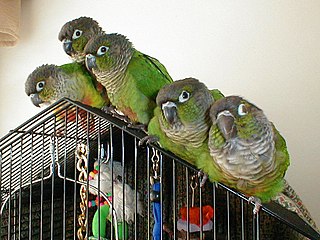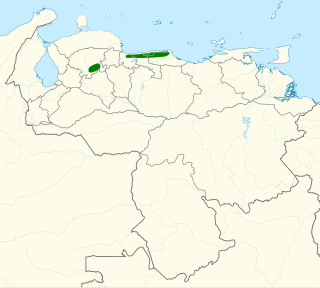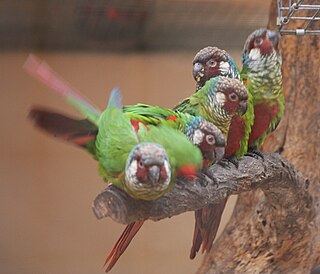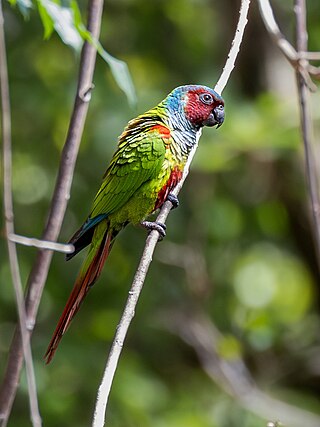
The green-cheeked parakeet, also sometimes known as the green-cheeked conure in aviculture, is a species of bird in subfamily Arinae of the family Psittacidae, the African and New World parrots. It is found in Argentina, Bolivia, Brazil, and Paraguay.

The sulphur-winged parakeet, also known as Hoffmann's conure in aviculture, is a species of bird in subfamily Arinae of the family Psittacidae, the African and New World parrots. It is found in Costa Rica and Panama.

Pyrrhura is a genus of parrots in the Arini tribe. They occur in tropical and subtropical South America and southern Central America. Most are restricted to humid forest and adjacent habitats, but one species, the blaze-winged parakeet, prefers deciduous or gallery woodland, and another, the Pfrimer's parakeet, is restricted to dry regions. Some species are highly endangered.

The Caatinga parakeet, also called the cactus parakeet and in aviculture the cactus conure, is a species of bird in subfamily Arinae of the family Psittacidae, the African and New World parrots. It is endemic to eastern Brazil.

The brown-throated parakeet, also known as the St. Thomas conure or brown-throated conure in aviculture, is a species of bird in the subfamily Arinae of the family Psittacidae, the African and New World parrots. It is found in Costa Rica, Panama, the northern mainland of South America, and islands off the South American coast.

The grey-cheeked parakeet, less commonly known as fire-winged parakeet, is a vulnerable species of bird in the subfamily Arinae of the family Psittacidae, the African and New World parrots. It is found in Ecuador and Peru.

The tui parakeet is a species of bird in subfamily Arinae of the family Psittacidae, the African and New World parrots. It is found in Bolivia, Brazil, Colombia, Peru, and possibly Ecuador.

The white-breasted parakeet or white-necked parakeet is a Vulnerable species of bird in subfamily Arinae of the family Psittacidae, the African and New World parrots. It is found in southern Ecuador and possibly in adjacent northern Peru.

The blaze-winged parakeet, known as the blaze-winged conure in aviculture, is a species of bird in subfamily Arinae of the family Psittacidae, the African and New World parrots. It is found in Brazil, Bolivia, Paraguay, and possibly Argentina.

The blood-eared parakeet, also known as the red-eared parakeet and in aviculture as the red-eared conure, is a species of bird in subfamily Arinae of the family Psittacidae, the African and New World parrots. It is endemic to Venezuela.

The pearly parakeet, known as the pearly conure in aviculture, is a Vulnerable species in subfamily Arinae of the family Psittacidae, the African and New World parrots. It is endemic to Brazil.

The El Oro parakeet is an Endangered species of bird in subfamily Arinae of the family Psittacidae, the African and New World parrots. It is endemic to Ecuador.

The painted parakeet, known as the painted conure in aviculture, is a species of bird in subfamily Arinae of the family Psittacidae, the African and New World parrots. It is found in Brazil, Colombia, French Guiana, Guyana, Panama, Suriname, and Venezuela.

The white-eared jacamar is a species of bird in the family Galbulidae. It is found in Brazil, Colombia, Ecuador and Peru.

The white-eared parakeet or maroon-faced parakeet is a Vulnerable species of bird in subfamily Arinae of the family Psittacidae, the African and New World parrots. It is endemic to Brazil.

Pfrimer's parakeet is a non-migratory species within the parrot family Psittacidae. It also is known as Pfrimer's conure, Goias parakeet, and maroon-faced conure. The Pfrimer's parakeet has been qualified as endangered by the IUCN and BirdLife International since 2007. It is endemic to the Goiás and Tocantins regions of Brazil. It is mainly found within a belt of dry deciduous and semi-deciduous areas of the Caatinga forest.

The rose-fronted parakeet, known as the rose-fronted conure in aviculture, is a species of bird in the subfamily Arinae of the family Psittacidae, the African and New World parrots. It is found in Bolivia, Brazil, Ecuador, and Peru.

The Santarém parakeet, also known as Hellmayr's parakeet or in aviculture as Hellmayr's conure or the Santarém conure, is a species of parrot in the family Psittacidae. It is found in the eastern and central sections of the Amazon basin south of the Amazon River, only just extending onto the northern bank of this river.

Bonaparte's parakeet, also known as Deville's parakeet, or in aviculture as Deville's conure, is a species of parrot in the family Psittacidae. It is restricted to the Brazilian state of Amazonas south of the Solimões river.

The Venezuelan parakeet or Emma's conure is a species of bird in subfamily Arinae of the family Psittacidae, the African and New World parrots. It is endemic to Venezuela.























